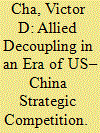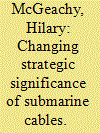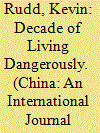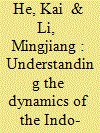|
|
|
Sort Order |
|
|
|
Items / Page
|
|
|
|
|
|
|
| Srl | Item |
| 1 |
ID:
175854


|
|
|
|
|
| Summary/Abstract |
The turn towards an openly competitive relationship between the United States and China today carries acute consequences for U.S. policy toward North Korea (Democratic People’s Republic of Korea or DPRK) and South Korea (Republic of Korea or ROK). The military and economic requirements of enacting such a policy of competition with China complicates U.S. policy with its ally South Korea, as it exacerbates three core dilemmas that the ROK contends with regarding China. These dilemmas compel choices for a U.S. ally that must increasingly become zero-sum in nature where Seoul must make choices that alienate its patron ally or its neighbor. This article draws out propositions for how changes in U.S.-China relations impacts strategy on both sides of the Korean peninsula. The primary finding is that changes in the independent variable (U.S.-China relations) have opposing impacts on South Korean and North Korean strategic thinking (dependent variable). What might be considered opportunities afforded by U.S.-China relations to South Korea are seen as threats by North Korea. Conversely opportunities created by U.S.-China relations for North Korea register as threats for South Korea.
|
|
|
|
|
|
|
|
|
|
|
|
|
|
|
|
| 2 |
ID:
185168


|
|
|
|
|
| Summary/Abstract |
The strategic significance accorded to submarine cables has never been a static concept, but it has been homogenous: a focus on protecting cables from external threats. This article argues that because submarine cables have long had strategic value, they provide a means to examine the emerging concept of strategic technology competition between the United States and China. To do so, this article examines major changes to the submarine cable sector since 2015, including the success of Chinese company Huawei Marine, and US and other western government interventions in several cable projects. It characterises the strategic considerations exhibited by submarine cable activity in that period – influence building in third countries, a changing perception among the US and its partners of threat and protection priorities, and closer attention to cable security and surveillance considerations – and compares them with the traditional strategic values attached to submarine cables. It concludes strategic concerns about undersea cables includes a new concept: the construction and installation of cables as a strategic threat, and which adds complexity to a sector in which it is difficult to project influence. This article seeks to make a contribution to scholarship on strategic competition in emerging technologies.
|
|
|
|
|
|
|
|
|
|
|
|
|
|
|
|
| 3 |
ID:
179878


|
|
|
|
|
| Summary/Abstract |
The US–China relationship is experiencing its worst period of tension since the normalisation of relations more than 40 years ago. The world is now entering a "decade of living dangerously", in which conflict between the two great powers is no longer unthinkable. What does this growing competition mean for the rest of Asia? This article traces the reality of the regional impact of the last four years of US–China relations under the Xi Jinping and Trump administrations before looking ahead to what the next four years of a Biden administration may bring for the Indo-Pacific. It concludes with reflections on the region's independence and agency, what can be done to strengthen regional multilateralism, and the how and why of building a genuine regional security architecture.
|
|
|
|
|
|
|
|
|
|
|
|
|
|
|
|
| 4 |
ID:
168166


|
|
|
|
|
| Summary/Abstract |
In recent years, Chinese scholars and policy elites have discussed the ever intensifying strategic competition between the United States and China and its multifaceted implications for Chinese foreign policy. Some even worry about the possibility of a new Cold War between the United States and China. This article aims to offer an analysis of Chinese perspectives on US–China strategic competition. In the view of most Chinese observers, US–China strategic competition is inevitable because China is closing the national power gap between itself and the United States, while the latter resolutely upholds its global primacy. Other factors, including ideological disagreements, may fuel the major power competition that has extended to most aspects of US–China relations. Chinese observers believe that economic and technological rivalry between the United States and China has heightened and that the Western Pacific is the focal point of US–China strategic competition. Meanwhile, certain Chinese scholars attach greater importance to US–China competition over international prestige and leadership. However, Chinese analysts are not overly pessimistic about the prospects for US–China relations and have raised policy recommendations geared to managing US–China strategic competition and restoring a new equilibrium between the two major powers.
|
|
|
|
|
|
|
|
|
|
|
|
|
|
|
|
| 5 |
ID:
176235


|
|
|
|
|
| Summary/Abstract |
As a geographical concept, ‘Indo-Pacific’ has existed for decades. As a political and strategic concept, it has since 2010 gradually become established in the foreign policy lexicon of some countries, especially Australia, India, Japan and the United States. However, China seems to be reluctant to identify itself as part of the Indo-Pacific; Chinese leaders believe that the US-led Indo-Pacific strategy aims to contain China's rise. While the battle between the two geographical concepts ‘Indo-Pacific’ and ‘Asia–Pacific’ may be fairly easily settled in the future, US–China strategic competition has just begun. Will the Indo-Pacific become a battlefield for US–China rivalry? How will China cope with the US ‘free and open Indo-Pacific’ (FOIP) strategy? How will other regional actors respond to the US–China strategic competition in the Indo-Pacific? What are the strategic implications of the ‘Indo-Pacific’ concept for regional order transformation? How will the Indo-Pacific be institutionalized, economically, politically and strategically? This article introduces the January 2020 special issue of International Affairs, which aims to address those questions, using both country-specific and regional perspectives. Seven articles focus on the policy responses of major players (Australia, China, India, Indonesia, Japan and ASEAN) to the US FOIP strategy and related US–China rivalry in the region. A further three articles examine the profound implications of Indo-Pacific dynamics for regional institution-building and for geopolitical and geo-economic architecture.
|
|
|
|
|
|
|
|
|
|
|
|
|
|
|
|
|
|
|
|
|